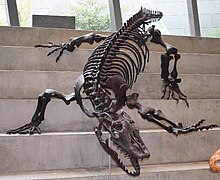古巨蜥
| 古巨蜥 化石时期:更新世
| |
|---|---|

| |
| 科学分类 | |
| 界: | 动物界 Animalia |
| 门: | 脊索动物门 Chordata |
| 纲: | 爬行纲 Reptilia |
| 目: | 有鳞目 Squamata |
| 科: | 巨蜥科 Varanidae |
| 属: | 巨蜥属 Varanus |
| 种: | 古巨蜥 V. priscus
|
| 二名法 | |
| Varanus priscus (Owen, 1859)
| |
| 异名[1][2] | |
|
原用名
| |
古巨蜥(学名:Varanus priscus)又名巨齿蜥,是一种已灭绝的巨型巨蜥。它们生存于更新世的南澳洲,约于4万年前消失。最早到达的澳洲原住民可能曾与之一同生活。[3]
科学分类[编辑]

分类及命名[编辑]
古巨蜥是由理查·欧文(Richard Owen)所描述,并取命名为Megalania prisca,意为“古代巨型的流浪者”。[1] 欧文最初将古巨蜥分类在自己的属中,但此属的有效性却被受质疑,认为是巨蜥属的异名。[4] 由于Megalania及巨蜥属的性别不同,种小名也由prisca改为priscus。[5]
系统发生学[编辑]
多项研究都尝试找出古巨蜥在巨蜥属内的系统发生学位置。其中一个指它们的头颅骨顶形态与眼斑巨蜥相似,认为与之相近。[6] 另一项较近期的研究则指它们与科莫多龙的脑颅结构相似,故与之应为姊妹分类,而树巨蜥则为其最近亲。[7]
体型[编辑]


古巨蜥没有留下完整或接近完整的骨骼,故很难确定其大小。[4] 早期估计它们最大约有7米长,及重600-620公斤。[8] 于2002年,斯蒂芬·罗(Stephen Wroe)就认为古巨蜥最多只有4.5米长及重331公斤[9],而平均则长3.5米及重97-158公斤。[9][10] 他认为早期的计算是基于错误的方法及夸大了其体型。[9]
不过,Ralph Molnar于2004年基于脊骨及总体长的研究,指古巨蜥的体长有几种可能性。[4] 若古巨蜥像树巨蜥般拥有幼长的尾巴,它们有可能长达7.9米;若它们的尾巴与体型的比例像近亲科莫多龙,则体长约等于7米。以7米的体长来计算,它们可以重达1940公斤.而平均重320公斤。[4]
古生物学[编辑]
古巨蜥是已知最巨型的陆上蜥蜴(海中最大的蜥蜴则是沧龙),它们的四肢及身体强壮,头颅骨很大,眼睛间有细小的冠,颚骨上长满锯齿状的牙齿。[5] 从其体型来推断,它们主要猎食中型至大型的动物,包括任何巨型的有袋类(如双门齿兽)、爬行类、细小的哺乳动物及鸟类。
斯蒂芬·罗等人怀疑古巨蜥是否澳洲巨型动物群的主要掠食者。[11] 他们发现袋狮曾残杀非常巨型的更新世哺乳动物,但古巨蜥却没有。他们也发现古巨蜥的化石并不普遍,与袋狮的分布相形见绌。
提姆·富兰纳瑞(Tim Flannery)认为要重构澳洲原住民到达澳洲前的生态系统,最理想的方法是以科莫多龙来取代古巨蜥。[12]
毒素[编辑]
研究发现其他巨蜥属的成员,如科莫多龙,沿颚部都有毒腺。[13] 所以有指古巨蜥也可能有类似的毒腺。[14] 若真是这样,古巨蜥将会是最巨大的有毒脊椎动物。
参考文献[编辑]
- ^ 1.0 1.1 Owen R. Description of Some Remains of a Gigantic Land-Lizard (Megalania Prisca, Owen) from Australia. Philosophical Transactions of the Royal Society of London. 1859, 149: 43–48. JSTOR 108688. doi:10.1098/rstl.1859.0002.
- ^ Lydekker R. Catalog of the fossil Reptilia in the British Museum (Natural History) Cromwell Road S.W. Pt. 1: The Orders Ornithosauria, Crocodilia, Squamata, Rhynchocephalia, and Proterosauria. London: The Trustees. 1888. Cited in Molnar RE. The long and honorable history of monitors and their kin. King, Ruth Allen; Pianka, Eric R.; King, Dennis (编). Varanoid lizards of the world. Bloomington: Indiana University Press. 2004: 45. ISBN 0-253-34366-6.)
- ^ Megalania, giant ripper lizard Archive.is的存档,存档日期2012-05-26, BBC - Science & Nature
- ^ 4.0 4.1 4.2 4.3 Molnar, R.E. Dragons in the Dust: The paleobiology of the giant monitor lizard Megalania. Indiana University Press. 2004.
- ^ 5.0 5.1 Molnar, R.E. History of monitors and their kin. Pianka, E.R., King, D. and King, R.A. (Editors) (编). Varanoid lizards of the world. Indiana University Press. 2004: 588 pp.
- ^ Lee MSY. Possible affinities between Varanus giganteus and Megalania prisca. Memoirs of the Queensland Museum. 1996, 39: 232.
- ^ Head, JJ.; Barrett, PM.; Rayfield, EJ. Neurocranial osteology and systematic relationships of Varanus (Megalania) prisca Owen, 1859 (Squamata: Varanidae). Zoological Journal of the Linnean Society. 2009, 2009 (155): 445–57.
- ^ Hecht, M. The morphology and relationships of the largest known terrestrial lizard, Megalania prisca Owen, from the Pleistocene of Australia. Proceedings of the Royal Society of Victoria. 1975, 87: 239–50.
- ^ 9.0 9.1 9.2 Wroe, S. A review of terrestrial mammalian and reptilian carnivore ecology in Australian fossil faunas, and factors influencing their diversity: the myth of reptilian domination and its broader ramifications (PDF). Australian Journal of Zoology. 2002, 50: 1–24 [2009-09-28]. (原始内容 (PDF)存档于2003-12-10).
- ^ Wroe S, Field J, Fullagar R, & Jermiin LS. Megafaunal extinction in the late Quaternary and the global overkill hypothesis. Alcheringa. 2004, 28: 291–331.
- ^ Wroe S, Myers TJ, Wells RT & Gillespie, A. Estimating the weight of the Pleistocene marsupial lion, Thylacoleo carnifex (Thylacoleonidae : Marsupialia): implications for the ecomorphology of a marsupial super-predator and hypotheses of impoverishment of Australian marsupial carnivore faunas. Australian Journal of Zoology. 1999, 47: 489–98.
- ^ Flannery T. The Future Eaters. 1994: pp. 384–5. ISBN 0-8021-3943-4.
- ^ Fry, B.; et al. Early evolution of the venom system in lizards and snakes. Nature. February 2006, 439: 584–8 [2009-09-28]. doi:10.1038/nature04328. (原始内容存档于2009-04-19).
- ^ Komodo Dragons Kill With Venom, Researchers Find (页面存档备份,存于互联网档案馆) (National Geographic)
外部链接[编辑]
|
